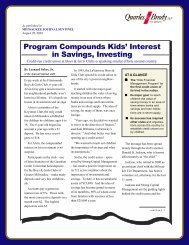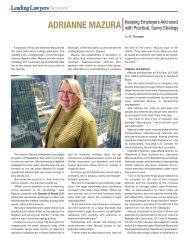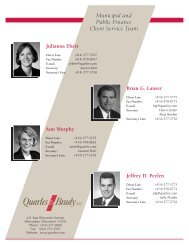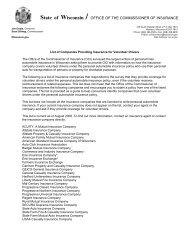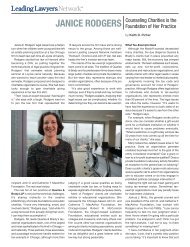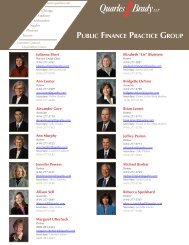Labor and Employment Law - Quarles & Brady LLP
Labor and Employment Law - Quarles & Brady LLP
Labor and Employment Law - Quarles & Brady LLP
You also want an ePaper? Increase the reach of your titles
YUMPU automatically turns print PDFs into web optimized ePapers that Google loves.
Reprinted with permission from the 2012 edition of Annual Survey of Wisconsin <strong>Law</strong>, (c) State Bar of Wisconsin 2012. To order the complete<br />
Annual Survey or for information on other PINNACLE books, contact the State Bar of Wisconsin at marketplace.wisbar.org/BooksKnowledgeProducts.<br />
<strong>Labor</strong> <strong>and</strong> <strong>Employment</strong> <strong>Law</strong><br />
by Courtney R. Heeren<br />
Courtney R. Heeren is an associate with <strong>Quarles</strong> & <strong>Brady</strong> <strong>LLP</strong>, Milwaukee. She practices in the<br />
firm’s <strong>Labor</strong> & <strong>Employment</strong> Group, representing management with an emphasis on the defense of<br />
discrimination <strong>and</strong> other employment-related claims in front of administrative, state, <strong>and</strong> federal<br />
agencies <strong>and</strong> courts. She also focuses on day-to-day client counseling on a variety of compliance<br />
<strong>and</strong> human-resource issues. She is a member of the American Bar Association, the State Bar of<br />
Wisconsin, <strong>and</strong> the Milwaukee Young <strong>Law</strong>yers Association, <strong>and</strong> she is a co-chair of the Association<br />
of Women <strong>Law</strong>yers’ Pro Bono Committee. Ms. Heeren received her B.A. in English <strong>and</strong> French<br />
from the University of Wisconsin <strong>and</strong> her J.D. from Northeastern University School of <strong>Law</strong>.<br />
This chapter reviews significant Wisconsin judicial <strong>and</strong> statutory developments of 2011 in the area of labor <strong>and</strong><br />
employment law. Wisconsin’s legislative changes to its labor <strong>and</strong> employment laws put the state in the national<br />
spotlight with 2011 Wisconsin Act 10 (known as the Scott Walker Budget Repair Bill) <strong>and</strong> its amendments regarding<br />
public employees’ collective bargaining rights. Although Act 10 dominated the labor <strong>and</strong> employment discussion<br />
for much of 2011, other significant legislative <strong>and</strong> judicial developments occurred during the year as well.<br />
Milwaukee’s paid sick leave ordinance was put into effect by the court of appeals but later preempted by state<br />
legislation. The court of appeals clarified overtime calculations under Wisconsin law <strong>and</strong> examined the statutes of<br />
limitation for filing a discrimination charge. A new concealed-carry law went into effect in November 2011, making<br />
Wisconsin the 49th state to allow individuals to carry concealed weapons. In addition, prevailing wage laws were<br />
returned to 2009 st<strong>and</strong>ards, <strong>and</strong> child labor laws governing hours worked were amended to parallel requirements<br />
under federal law. 1<br />
CASE LAW<br />
Court of Appeals Upholds Milwaukee Paid Sick Leave Ordinance<br />
On November 4, 2008, voters passed a referendum m<strong>and</strong>ating paid sick leave for all private-sector employees<br />
working in the city of Milwaukee. The terms of the ordinance required that covered employers give employees 1<br />
hour of paid sick leave for every 30 hours worked, up to 72 hours (or nine days) of leave per calendar year. The<br />
ordinance required smaller employers (those with fewer than 10 employees) to provide 40 hours (or five days) of<br />
paid sick leave per calendar year.<br />
In Metropolitan Milwaukee Ass’n of Commerce v. City of Milwaukee, 2011 WI App 45, 332 Wis. 2d 459, 798<br />
N.W.2d 287, the court of appeals upheld the Milwaukee paid sick leave ordinance, sending the case back to the<br />
circuit court with an order to lift the permanent injunction that the circuit court had placed on implementation of the<br />
ordinance in 2010.<br />
The circuit court’s injunction was the result of a legal challenge brought by the Metropolitan Milwaukee Association<br />
of Commerce (MMAC). The MMAC had challenged the referendum on a number of grounds: (1) The ballot on<br />
which the referendum was listed did not comply with the statutory requirement that it be a “concise statement of [the<br />
ordinance’s] nature,” see Wis. Stat. § 9.20(6); (2) the ordinance violated substantive due process because there was<br />
not a rational relationship to the city’s police powers; (3) the ordinance was preempted by state statutes; (4) the<br />
ordinance was preempted by the National <strong>Labor</strong> Relations Act (NLRA) <strong>and</strong> the <strong>Labor</strong> Management Relations Act<br />
1 Textual references to the Wisconsin Statutes are indicated as “chapter xxx” or “section xxx.xx,” without the designation “of the<br />
Wisconsin Statutes.” Unless otherwise indicated, in the Statutory Developments section of this chapter, all references to the<br />
Wisconsin Statutes are to the 2009–10 Wisconsin Statutes, as affected by acts through 2011 Wisconsin Act 113.<br />
© April 2012, State Bar of Wisconsin PINNACLE 157<br />
G:\CLE\Books\Books\DISCOVERY\2006_Discovery\book7.discovery05.fin.doc 02/01/06
<strong>Labor</strong> <strong>and</strong> <strong>Employment</strong> <strong>Law</strong> Annual Survey of Wisconsin <strong>Law</strong><br />
(LMRA); (5) the ordinance violated the state <strong>and</strong> federal constitutional prohibitions against impairment of contracts;<br />
(6) the ordinance regulated activity outside the city limits; <strong>and</strong> (7) the statutory two-year period during which the<br />
ordinance may not be repealed or amended except by a vote of the electors, see Wis. Stat. § 9.20(8), began to run<br />
when the ordinance initially passed <strong>and</strong> continued to run even while the ordinance was enjoined.<br />
The court of appeals disagreed on every point raised by the MMAC, focusing on the following issues. First, the<br />
court found that the ballot, despite the fact that it did not list each reason for which an employee could take leave<br />
under the ordinance, qualified as a concise statement of the ordinance’s nature within the meaning of section<br />
9.20(6). MMAC, 2011 WI App 45, ¶ 44, 332 Wis. 2d 459. The court found that there had been other means for<br />
voters to have learned about the details of the proposed ordinance’s content, including a posting at each polling<br />
place, <strong>and</strong> it was not necessary for the ballot to spell out every detail. Id. ¶ 33.<br />
Second, the court disagreed with the MMAC that the ordinance was not a valid exercise of the city’s police powers.<br />
Applying the legal st<strong>and</strong>ard that the legislative means chosen must have a rational relationship to the purpose or<br />
object of the enactment <strong>and</strong> that the object must be a proper one, the court concluded that there was a reasonable<br />
relationship between the ordinance <strong>and</strong> a legitimate municipal objective—namely, the health, safety, <strong>and</strong> welfare of<br />
the city’s residents. Id. ¶¶ 49, 51, 57. The court also held that the minimum annual-sick-leave time established by<br />
the ordinance—72 hours (or 40 hours for small businesses)—was not unreasonable. Id. ¶ 79.<br />
Next, the court addressed the MMAC’s arguments that the ordinance was preempted by either state or federal law.<br />
The MMAC had asserted that the ordinance was preempted by three state statutes: the minimum wage law, chapter<br />
104; the Family or Medical Leave Act (FMLA), section 103.10; <strong>and</strong> the Worker’s Compensation Act, chapter 102.<br />
Id. ¶ 80. Because the minimum wage law does not consider benefits except tips, meals, <strong>and</strong> lodging, <strong>and</strong> because<br />
the ordinance did not increase the hourly wage rate as defined by the Department of Workforce Development<br />
(DWD), the court concluded that the ordinance—which only addressed additional sick leave benefits—was not<br />
preempted by chapter 104. Id. ¶ 83. The court also disagreed that the Wisconsin FMLA preempted the ordinance,<br />
finding that the ordinance <strong>and</strong> the statute did not logically conflict because the text of the Wisconsin FMLA statute<br />
allows for its coexistence with other forms of leave. Id. ¶ 84. Lastly, the court disagreed that the Worker’s<br />
Compensation Act preempted the ordinance, finding that that statute specifically allowed for overlapping benefits<br />
similar to those provided for in the ordinance. Id. ¶ 86.<br />
The court also rejected the MMAC’s argument that federal law—specifically, the NLRA <strong>and</strong> the LMRA—<br />
preempted the ordinance. Regarding NLRA preemption, the court found that the ordinance created minimum labor<br />
st<strong>and</strong>ards as have been carved out in NLRA case law as specifically not leading to preemption. Id. ¶ 92. Regarding<br />
LMRA preemption, the court found that application of the ordinance did not require interpretation of collective<br />
bargaining agreements since it established rights <strong>and</strong> obligations independent of labor contracts <strong>and</strong>, therefore, also<br />
did not lead to preemption. Id. ¶ 95.<br />
The court of appeals reversed the circuit court’s decision, rem<strong>and</strong>ing the matter with orders to grant summary<br />
judgment in favor of the Milwaukee chapter of the 9to5 National Association of Working Women (an intervenor<br />
supporting implementation of the ordinance) <strong>and</strong> to lift the permanent injunction. Id. ¶ 114. 9to5’s victory,<br />
however, was short-lived: Before the ordinance could go into effect, the state legislature passed a law, discussed<br />
below in the Statutory Developments section, completely preempting it.<br />
Clarifying Overtime Calculations<br />
The court of appeals reviewed the issue of calculating overtime under Wisconsin law in Kuhnert v. Advanced Laser<br />
Machining, Inc., 2011 WI App 23, 331 Wis. 2d 625, 794 N.W.2d 805 (review denied). Kuhnert had worked as an<br />
entry/scheduling clerk <strong>and</strong> purchasing agent for Advanced Laser <strong>and</strong> was paid on a salary basis. Id. ¶ 2. After<br />
Kuhnert was discharged, she filed a wage complaint with the DWD alleging that she was improperly classified as an<br />
overtime-exempt employee <strong>and</strong> she was entitled to recover unpaid overtime wages. Id. ¶ 3.<br />
Although the DWD’s <strong>Labor</strong> St<strong>and</strong>ards Bureau director found in Kuhnert’s favor, finding that her position was not<br />
overtime exempt <strong>and</strong> that she therefore should have received overtime pay, he did not award her the amount of<br />
backpay to which she believed she was entitled, <strong>and</strong> Kuhnert appealed the matter to the circuit court.<br />
158 © April 2012, State Bar of Wisconsin PINNACLE<br />
G:\CLE\Books\Books\TYPE\Year_Type\filename.doc 02/01/06
Annual Survey of Wisconsin <strong>Law</strong> <strong>Labor</strong> <strong>and</strong> <strong>Employment</strong> <strong>Law</strong><br />
To reach his overtime calculation, the <strong>Labor</strong> St<strong>and</strong>ards Bureau director used the following method: (1) determine<br />
the average hourly rate of pay per pay period by dividing total regular wages received in a pay period (salary) by the<br />
total hours worked; (2) determine the “overtime premium rate” by dividing the “average hourly rate” by two; <strong>and</strong><br />
(3) multiply the overtime premium rate for each pay period by the overtime hours worked to determine the overtime<br />
premium pay due. Id. ¶ 4. The <strong>Labor</strong> St<strong>and</strong>ards Bureau director’s decision specifically pointed out that people<br />
often think of overtime pay as one <strong>and</strong> one-half times the regularly hourly rate, but he stated that is an error. Id. He<br />
observed that it is actually the “regular rate” plus the overtime premium rate. Id.<br />
Kuhnert used a different method for calculating overtime, which she claimed resulted in her being owed<br />
approximately $12,000, in contrast with the $2,699.25 in overtime pay that she would be owed according to the<br />
DWD’s calculation. Id. ¶ 1. She argued that the DWD should have calculated her overtime pay by (1) dividing her<br />
normal weekly salary by the number of hours she was expected to work per week to determine her regular rate of<br />
pay; (2) multiplying the regular rate of pay by 1.5 to determine her overtime rate; <strong>and</strong> (3) multiplying the overtime<br />
rate by the number of overtime hours worked each week. Id. ¶ 5.<br />
The court of appeals gave great-weight deference to the DWD’s calculation <strong>and</strong> affirmed its decision. The court of<br />
appeals acknowledged that the relevant statutory <strong>and</strong> administrative text—section 103.025(1)(c) <strong>and</strong> Wisconsin<br />
Administrative Code section DWD 274.03—required that a nonexempt employee be compensated for overtime<br />
hours at a rate of one <strong>and</strong> one-half times the regular rate of pay. But the court also observed that the statutes <strong>and</strong><br />
administrative code left the regular rate of pay <strong>and</strong> the method for calculating it undefined. The DWD had<br />
developed a method to determine overtime pay for a nonexempt salaried employee, id. ¶ 14 (citing DWD<br />
publication ERD-13109-P), <strong>and</strong> the court determined that this method was consistent with the requirements of the<br />
Wisconsin Statutes <strong>and</strong> the Wisconsin Administrative Code, with the supreme court’s approach for calculating<br />
overtime wages, <strong>and</strong> with the DWD’s long-st<strong>and</strong>ing practice. Id. ¶¶ 14–18. Based on this analysis, the court<br />
concluded that the DWD’s interpretation was a reasonable one.<br />
Clarifying the 300-Day Statutes of Limitation for Filing a Discrimination Charge<br />
In Aldrich v. LIRC, 2011 WI App 94, 334 Wis. 2d 495, 801 N.W.2d 457 (review granted), the court of appeals<br />
examined the 300-day statutes of limitation applicable to filing discrimination charges with the U.S. Equal<br />
<strong>Employment</strong> Opportunity Commission (EEOC) <strong>and</strong> the Wisconsin Equal Rights Division (ERD) <strong>and</strong> addressed<br />
whether a plaintiff could relitigate the timeliness of a charge under the Wisconsin Fair <strong>Employment</strong> Act (WFEA)<br />
when the timeliness under federal law had already been litigated. The relevant statutes of limitation can be found at<br />
42 U.S.C. § 2000e-5(e)(1) <strong>and</strong> section 111.39(1).<br />
Joyce Aldrich had signed a Charge Questionnaire with the EEOC on August 27, 2003. She had been demoted from<br />
her position at Best Buy in March 2003. Id. ¶ 4. According to Aldrich, she understood her charge to have been filed<br />
when she signed the questionnaire. Id. The EEOC investigator notified Aldrich two days after she had signed the<br />
questionnaire that it was necessary to speak with her to obtain all the information the investigator needed to draft the<br />
charge, requesting that Aldrich contact the investigator within five days after receiving the investigator’s letter. Id.<br />
Aldrich later did have contacts with EEOC investigators <strong>and</strong> signed a charge of age <strong>and</strong> sex discrimination, which<br />
the EEOC received on February 10, 2004, more than 300 days after the demotion at issue. Id. ¶ 5. Pursuant to a<br />
work-sharing agreement between the EEOC <strong>and</strong> the ERD, the ERD received the charge on February 18, 2004. Id.<br />
Following an investigation, the EEOC dismissed Aldrich’s claims, <strong>and</strong> Aldrich filed a federal action, alleging sex<br />
<strong>and</strong> age discrimination, as well as constructive discharge. Id. ¶ 6. Best Buy successfully won a motion to dismiss<br />
on the basis that Aldrich’s charge had not been timely filed <strong>and</strong> that her charge, although it included allegations<br />
regarding her demotion, did not include any allegations regarding her subsequent discharge. Id. Aldrich did not<br />
appeal the dismissal. Id.<br />
Instead, Aldrich requested that the ERD independently investigate the charge. Id. ¶ 7. Following its investigation,<br />
the ERD found that there was probable cause to believe that Aldrich had been discriminated against. Id. However,<br />
during the subsequent hearing, the administrative law judge (ALJ) granted Best Buy’s motion to dismiss on the<br />
ground of claim preclusion—namely, that Aldrich had already litigated this claim in federal court. Id. Although the<br />
<strong>Labor</strong> <strong>and</strong> Industry Review Commission (LIRC) affirmed the ALJ’s dismissal, the circuit court reversed. The court<br />
of appeals affirmed the circuit court, finding that the doctrine of claim preclusion did not apply to Aldrich’s claims<br />
© April 2012, State Bar of Wisconsin PINNACLE 159<br />
G:\CLE\Books\Books\TYPE\Year_Type\filename.doc 02/01/06
<strong>Labor</strong> <strong>and</strong> <strong>Employment</strong> <strong>Law</strong> Annual Survey of Wisconsin <strong>Law</strong><br />
because Aldrich had not been able to bring her claims under Wisconsin’s specific antidiscrimination statute—the<br />
WFEA—in the prior federal action. Id. On rem<strong>and</strong> to the ERD, Best Buy again moved to dismiss, this time on<br />
grounds that Aldrich’s demotion claims were time-barred because the federal court had found her EEOC charge<br />
untimely <strong>and</strong>, therefore, her complaint filed with the ERD was also untimely. Id. ¶ 8. Best Buy maintained that<br />
issue preclusion barred reconsideration of the issue of timeliness because it had already been litigated in the federal<br />
action. Id. The ALJ granted the motion, <strong>and</strong> LIRC affirmed, but the circuit court again vacated LIRC’s decision.<br />
Id.<br />
Following Best Buy’s appeal, the court of appeals affirmed LIRC’s finding that issue preclusion prevented such<br />
relitigation. Id. ¶ 1. The court of appeals found that Aldrich was not entitled to an independent review by a state<br />
court of whether the questionnaire she signed with the EEOC constituted a complaint within the meaning of<br />
Wisconsin Administrative Code section DWD 218.03(3). The court reasoned that the EEOC questionnaire was<br />
never physically received by the ERD <strong>and</strong> was therefore never “filed” with the ERD, much less filed within the<br />
requisite 300 days under section 111.39(1). Id. ¶ 13. The court further found that there was no provision for an<br />
independent state law analysis of whether such earlier-filed documents with the EEOC might satisfy the complaint<br />
requirement. Id. ¶ 15.<br />
The court of appeals also declined to allow for independent review of the timeliness of the charge itself. The court<br />
concluded that, by providing a mechanism to determine a single date for filing of cross-filed complaints, as well as a<br />
single analysis for compliance with the complaint requirement, the DWD precluded the possibility that a<br />
complainant could twice litigate a statute-of-limitation claim. Id. ¶ 16. The court found that the language of<br />
Wisconsin Administrative Code section DWD 218.03(5) “makes the date of filing with the EEOC dispositive for<br />
purposes of a cross-filed claim with the WFEA.” Id. ¶ 19. Because the correct EEOC filing date had already been<br />
litigated <strong>and</strong> fundamental fairness did not require otherwise, the court of appeals concluded that the application of<br />
issue preclusion was appropriate. Id. ¶ 22.<br />
STATUTORY DEVELOPMENTS<br />
Public Employees’ Collective Bargaining Rights Significantly Narrowed<br />
On March 11, 2011, Governor Scott Walker signed into law what is known as the Scott Walker Budget Repair Bill<br />
or Act 10. See 2011 Wis. Act 10. Among other amendments governing the compensation <strong>and</strong> fringe benefits of<br />
public employees, the act significantly limited the collective bargaining rights of certain public employees.<br />
Introduced on February 15, 2011, in the Wisconsin Assembly’s Committee on Assembly Organization as January<br />
2011 Special Session Assembly Bill 11 at the request of Governor Walker, the bill initially required additional<br />
public employee contributions for health care <strong>and</strong> pensions, curtailed collective bargaining rights for most state <strong>and</strong><br />
local public employees, <strong>and</strong> made appropriations. Because the bill contained appropriations, three-fifths of all<br />
members of each legislative house were required to be present for any vote on the passage to constitute a quorum.<br />
Wis. Const. art. VIII, § 8. Following its introduction, the bill was referred to the Joint Finance Committee, where it<br />
was amended <strong>and</strong> calendared for debate in the assembly on February 17, 2011. According to the bill’s paper<br />
history, it was debated for approximately 61 consecutive hours. Following amendment <strong>and</strong> approval in the<br />
assembly, the bill was passed to the Wisconsin State Senate on February 25, 2011. However, the senate, after<br />
reading the bill three times, could not proceed because it lacked a quorum. All 14 Democratic senators had absented<br />
themselves from the senate chambers before the senate’s consideration of the bill began—those senators left the<br />
state <strong>and</strong> did not appear publicly again in Madison until March 12, 2011.<br />
On March 9, 2011, a Joint Committee of Conference was created, <strong>and</strong> it amended the bill to remove the bill’s fiscal<br />
aspects so that three-fifths of each legislative house (i.e., 20 members in the senate) no longer needed to be present<br />
to pass the bill. The senate then approved the bill by a vote of 18–1 with no debate. On March 10, 2011, the<br />
assembly passed the bill by a vote of 53–42.<br />
A summary of the main aspects of Act 10 pertaining to the area of labor <strong>and</strong> employment is as follows. The<br />
provision of Act 10 that drew the most attention deals with the overall collective bargaining rights of public<br />
employees. Before passage of Act 10, municipal <strong>and</strong> state employees had the right to collectively bargain over<br />
160 © April 2012, State Bar of Wisconsin PINNACLE<br />
G:\CLE\Books\Books\TYPE\Year_Type\filename.doc 02/01/06
Annual Survey of Wisconsin <strong>Law</strong> <strong>Labor</strong> <strong>and</strong> <strong>Employment</strong> <strong>Law</strong><br />
wages, hours, <strong>and</strong> conditions of employment under the Municipal <strong>Employment</strong> Relations Act (MERA, see Wis.<br />
Stat. §§ 111.70–.77) <strong>and</strong> the State <strong>Employment</strong> <strong>Labor</strong> Relations Act (SELRA, see Wis. Stat. §§ 111.81–.94). Act 10<br />
amended MERA <strong>and</strong> SELRA with respect to all employees except certain public safety employees. Other than<br />
those excepted employees, public employees are limited to collectively bargain over base wages <strong>and</strong>, unless a<br />
referendum authorizes a larger increase, that percentage increase can be no greater than the percentage change in the<br />
consumer price index.<br />
Act 10 also prohibits salary deductions for labor organization dues except for public safety employees <strong>and</strong><br />
eliminates the ability of employees of the University of Wisconsin (UW) System, UW Hospitals <strong>and</strong> Clinics<br />
Authority, <strong>and</strong> certain home-care <strong>and</strong> child-care providers to collectively bargain over wages, hours, <strong>and</strong> conditions<br />
of employment.<br />
Act 10 also limits the terms of collective bargaining agreements <strong>and</strong> their ability to be extended. Specifically,<br />
before the Act 10 amendments, the term of collective bargaining agreements—other than initial collective<br />
bargaining agreements—was generally two years for state <strong>and</strong> municipal employees. Also, before Act 10, collective<br />
bargaining agreements could be extended. After Act 10, the term of collective bargaining agreements is limited to<br />
one year <strong>and</strong> extensions are prohibited.<br />
Although Act 10 was enjoined by the Dane County Circuit Court (State ex rel. Ozanne v. Fitzgerald, No. 11CV1244<br />
(Wis. Cir. Ct. Dane Cnty. Mar. 18, 2011)), the Wisconsin Supreme Court vacated the order to enjoin implementation<br />
of Act 10 in State ex rel. Ozanne v. v. Fitzgerald, 2011 WI 43, 334 Wis. 2d 70, 798 N.W.2d 436, <strong>and</strong> the act was<br />
republished on June 28, 2011, <strong>and</strong> took effect on June 29, 2011.<br />
Paid Sick Leave Preempted by State <strong>Law</strong><br />
As discussed above, the court of appeals revived Milwaukee’s paid sick leave ordinance on March 24, 2011, when it<br />
reversed the circuit court <strong>and</strong> rem<strong>and</strong>ed the matter with an order to grant summary judgment in favor of the<br />
intervenor supporting implementation of the ordinance <strong>and</strong> to lift the permanent injunction on the ordinance.<br />
Metropolitan Milwaukee Ass’n of Commerce v. City of Milwaukee, 2011 WI App 45, 332 Wis. 2d 459, 798 N.W.2d<br />
287. However, the impending implementation of the ordinance was short-lived. While the appeal was pending,<br />
both the Wisconsin Senate <strong>and</strong> the Wisconsin Assembly introduced companion bills to nullify the ordinance. Both<br />
houses ultimately passed the legislation, <strong>and</strong> Governor Walker signed it into law as 2011 Wisconsin Act 16,<br />
effective May 20, 2011. Act 16 provided that because family <strong>and</strong> medical leave is a statewide concern regarding<br />
which there should be consistency throughout the state, local governments could not enact local ordinances (such as<br />
the Milwaukee paid sick leave ordinance) requiring employers to provide paid or nonpaid leave for the reasons<br />
outlined in the act. See Wis. Stat. § 103.10(1m), as created by 2011 Wis. Act 16. Act 16 also specifically<br />
preempted any such ordinance (such as the Milwaukee paid sick leave ordinance) in place on the statute’s effective<br />
date. See Wis. Stat. § 103.10(1m)(e).<br />
Concealed-Carry <strong>Law</strong> Goes into Effect<br />
Effective November 1, 2011, Wisconsin became the 49th state to allow individuals to carry concealed weapons.<br />
The new law (2011 Wis. Act 35), which applies to all employers regardless of size, affects whether <strong>and</strong> how<br />
employers can prohibit weapons at work <strong>and</strong> on their property. Under the new legislation, residents 21 years <strong>and</strong><br />
older are allowed to carry a concealed weapon anywhere in the state, with only a few limited exceptions. Concealed<br />
weapons are still banned in schools, police stations, sheriff’s offices, prisons, jails, courthouses, <strong>and</strong> airports (but<br />
only beyond security checkpoints). Wis. Stat. § 175.60(16), as created by 2011 Wis. Act 35; see also Wis. Stat.<br />
§ 948.605(2) (gun-free school zones), as affected by 2011 Wis. Act 35.<br />
Under the new law, employers are still allowed to prohibit employees from carrying weapons (concealed or<br />
otherwise) while at work, both at the employer’s place of business <strong>and</strong> if the employee works off-site. However,<br />
employers can no longer prohibit employees from carrying or storing a weapon in the employee’s own motor<br />
vehicle. If an employer does choose to allow its employees to carry concealed weapons at work, the new law gives<br />
the employer immunity from lawsuits for any liability arising from that policy decision. Wis. Stat. § 175.60(21), as<br />
created by 2011 Wis. Act 35.<br />
© April 2012, State Bar of Wisconsin PINNACLE 161<br />
G:\CLE\Books\Books\TYPE\Year_Type\filename.doc 02/01/06
<strong>Labor</strong> <strong>and</strong> <strong>Employment</strong> <strong>Law</strong> Annual Survey of Wisconsin <strong>Law</strong><br />
Revised 2010 Prevailing Wage <strong>Law</strong> Repealed<br />
Effective January 1, 2010, the 2009 state budget act, see 2009 Wis. Act 28, had exp<strong>and</strong>ed the reach of Wisconsin’s<br />
prevailing wage laws (amending sections 66.0903, 103.49, <strong>and</strong> 103.50) so that public construction projects were<br />
subject to prevailing wage requirements if total completion costs (labor, equipment, <strong>and</strong> materials) exceeded<br />
$25,000 for both single-trade <strong>and</strong> multi-trade projects. A single-trade project of public works means a project in<br />
which a single trade accounts for at least 85% of the total labor costs of the threshold. Wis. Stat. § 103.49(1)(em),<br />
as created by 2011 Wis. Act 32, § 2390d; see also Wis. Stat. § 103.49(1)(e) (2007–08), repealed by 2009 Wis. Act<br />
28, § 2188. A multiple-trade project of public works means a project in which no single trade accounts for at least<br />
85% of the total labor cost of the project. Wis. Stat. § 103.49(1)(br), as created by 2011 Wis. Act 32, § 2390c; see<br />
also Wis. Stat. § 103.49(1)(bm) (2007–08), repealed by 2009 Wis. Act 28, § 2187. The 2009 budget act had<br />
lowered the cost-of-completion thresholds from $234,000 for multiple-trade projects <strong>and</strong> $48,000 for single-trade<br />
projects. See Wis. Stat. §§ 66.0903(5), 103.49(3g) (2007–08); Wis. Admin. Code § DWD 290.155(1) (June 2009).<br />
The 2011–13 Budget Bill, 2011 Wisconsin Act 32, repealed the prevailing-wage-law-related provisions of the 2009<br />
budget act, amending the prevailing wage law to the thresholds of $100,000 for a multiple-trade project of public<br />
works, $234,000 for a multiple-trade project of public works for a city or village with a population of less than 2,500<br />
or a town, <strong>and</strong> $48,000 for a single-trade project of public works. Wis. Stat. §§ 66.0903(5)(a), 103.49(3g)(a), as<br />
amended by 2011 Wis. Act 32, §§ 1727n, 2390m. As a result, the now repealed thresholds established by 2009<br />
Wisconsin Act 28 apply only to projects that awarded the prime contract during the effective period of the 2009<br />
Wisconsin Act 28 amendments—namely, January 1, 2010 through June 30, 2011. The revised thresholds, provided<br />
under 2011 Wisconsin Act 32, went into effect on July 1, 2011. Other significant changes included the repeal of the<br />
requirement that every contractor on a prevailing wage project submit a monthly certified record to the DWD on its<br />
website. Wis. Stat. §§ 66.0903(10)(am), 66.0904(8)(am), 103.49(5)(am) (2009–10), repealed by 2011 Wis. Act 32,<br />
§§ 1727t, 1727y, 2390s.<br />
Child <strong>Labor</strong> <strong>Law</strong>s<br />
The legislature amended Wisconsin’s child-labor hours’ limitations to align them with federal law. Under the<br />
revised law,<br />
1. Minors 16 years of age <strong>and</strong> over may not work during hours of required school attendance. Other than this<br />
requirement, the law no longer limits either the daily or weekly work hours of minors who are 16 years or older<br />
or the time of day that they may work.<br />
2. Minors under the age of 16 are limited to working (year-round) no more than three hours per day on school days<br />
<strong>and</strong> no more than eight hours per day on nonschool days.<br />
3. Minors under the age of 16 may work no longer than 18 hours in a school week, <strong>and</strong> their workday from the day<br />
after <strong>Labor</strong> Day through May 31 must be between the hours of 7:00 a.m. <strong>and</strong> 7:00 p.m.<br />
4. Minors under the age of 16 may work no longer than 40 hours in a nonschool week, <strong>and</strong> their workday from<br />
June 1 through <strong>Labor</strong> Day must be between the hours of 7:00 a.m. <strong>and</strong> 9:00 p.m.<br />
Wis. Stat. § 103.68, as affected by 2011 Wis. Act 32, §§ 2390zm, 2390zn, 2390zp.<br />
162 © April 2012, State Bar of Wisconsin PINNACLE<br />
G:\CLE\Books\Books\TYPE\Year_Type\filename.doc 02/01/06



